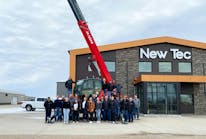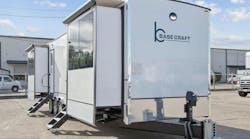Recent
Every day pumps are rented for different purposes. In these half dozen stories, pumps prevent sewage contamination; divert sewage 4,000 feet; protect a wastewater system; clean river intakes; purify a fish farm and provide fresh drinking water to 250,000 people a day. And more!
Thompson Pump Bridge Street Bypass Solves Potential Sewage Contamination
A Virginia city found itself with an issue. An old, worn-out bridge was badly in need of replacement, but tearing it down and constructing a new one could create long-lasting sewage problems far more serious than anything caused by a faulty bridge. A contracting firm would need to be hired, tasked with replacing the bridge while still preserving the integrity of the existing sewage system through which seven local pump stations flowed.
The job was made difficult because of the proximity of the sewage system to the area in which new construction would occur. City officials were afraid – and rightly so – that the vibration caused by driving the new bridge pillars into the ground would create fractures in the underground pipes, leading to the spilling of catastrophic amounts of sewage at the jobsite.
Shaw Construction was subcontracted to install the new utility work for the project which included bypassing the existing gravity sewer during bridge construction and rehabilitation of the two existing gravity siphon chambers. Shaw Construction immediately contacted Thompson Pump, a Port Orange, Fla.-based manufacturer of pumps and related equipment that also provides engineering expertise for construction dewatering, bypass, and emergency operations.
Thompson Pump was chosen because of its expertise in bypass work and its long-standing relationship with the contracting firm. The decision was made to use three Thompson 12-inch oil-less vacuum-assisted pumps and 18-inch HDPE pipe to bypass sewage from a manhole in front of the old bridge to a manhole on the other side of it – a distance of about 550 feet. These calculations were based on wastewater flow data provided to Shaw Construction and Thompson Pump during their initial meeting with the city’s sewage authority.
Thompson Pump fused the pipe and strung across the bridge using a crane. Once in place, the bypass was activated, allowing construction of the new bridge to commence last summer after months of planning.
From the very beginning, Thompson Pump sales engineer Steve Lyon’s flow meter gave him real-time water flow readings, and it did not take long to realize that the flow was significantly higher than anticipated. There were a several reasons why this occurred. The area had received above-average amounts of rainfall that allowed ground water and storm water to enter the collection systems (inflow and infiltration). New buildings had been built in the area, including an addition to the VA Hospital and several residential communities. Tidal fluctuations also added to the ever-changing flows. All totaled, what was expected to be about 14 million gallons per day turned out to be 19 million gallons each day.
Lyon and his staff remained undaunted. “We were very confident the pumps could handle the extra flow; we just knew we would have to run them harder,” he said. “Our two pumps ran at all times during the project, which lasted about five months – and there were times when the back-up pump was also in operation because of the increased water flow.”
Ever vigilant throughout the entire process, Lyon and his team were on 24-hour call, quickly responding when needed.
Thanks in large part to the Thompson Pump bypass system and its flawless performance, the construction proceeded as planned without interruption and was completed in January. Once finished, Thompson’s temporary bypass was removed, and it was “business as usual” when the new bridge opened.
Thompson Pump left a lasting impression upon city officials, to the point where they have since hired the company for multiple projects, present and future.
“Overall, I would say we are very happy with what happened during this project,” summed up Lyon. “Had we known water levels were going to be as high as they turned out to be, we would have set things up a little differently. For example, we would have deployed 24-inch pipe rather than the 18-inch pipe we used. But you always have to be prepared for the unexpected, and our products, most notably our oil-less vacuum-assisted pumps, performed just as we knew they would – even though we were demanding a lot more from them.”
Thompson Pump offers a revolutionary priming system with its oil-less vacuum technology (OVT). The OVT priming system offers multiple improvements to the traditional vacuum priming system. While both allow for a basic pump to prime automatically, the OVT does this more efficiently with no oil lubrication, lower maintenance and higher air handling for faster priming. In addition, the OVT system’s non-contacting rotors eliminate internal wear which increases longevity and provides the reliability of no decrease in performance over time. For this bypass job, this system was crucial.
“The biggest lesson learned from this project is the need for accurate flow data and flow documentation,” said Shane Harris, Project Manager Shaw Construction. “It is critical to have this information to prevent sewage spills and make decisions on the right equipment. Thompson Pump and Shaw Construction have built a superior relationship from working together.”
- Provided by Thompson Pump
@@@@@@@@@@@@@@@@@
Diverting 52,000 GPM of Sewage While New Pipeline is Installed
By Jim McMahon
Completed in September 2017, the sewage bypass project near Dallas, Texas, facilitated the replacement of two existing concrete sanitary sewage gravity lines with one new bigger combined line for the Trinity River Authority of Texas’ Central Regional Wastewater System. Critical to the project’s success was the use of nine high-volume, diesel-powered centrifugal pumps manufactured by Gorman-Rupp Pumps, which moved 52,000 gallons-per-minute of sewage 4,000 feet for 12 weeks in uninterrupted operation.
Serving 1.2 million people in the Dallas/Fort Worth area, the Trinity River Authority of Texas’ Central Regional Wastewater System maintains ongoing projects to upgrade its infrastructure. In early 2017, TRA contracted with Kodiak Trenching & Boring to bypass-pump the flows of two concrete sanitary sewage lines in the community of DeSoto, Texas, just south of Dallas. These 33-inch and 39-inch gravity lines were replaced with a single 48-inch line. The project required 52,000 gallons per minute of wastewater to be redirected 4,000 feet while the new line was being installed over an eight-week period. A comprehensive bypass-pumping plan was put into place, utilizing multiple, very large pumps to manage this high volume of effluent.
The plan encompassed redirecting the sewage away from the existing 33-inch and 39-inch gravity lines, which ran parallel to Ten Mile Creek, by pumping the wastewater from an upstream junction box, through a 42-inch and two 18-inch fused high density polyethylene discharge lines, to a manhole approximately three-quarters of a mile downstream. This would then permit the two gravity lines to be replaced without having to contend with sewage flow.
The bypass-pump plan was divided into two separate pumping systems, both occurring simultaneously: One system to divert the sewage from the 33-inch line, and the other system to divert the sewage from the 39-inch line.
Kodiak retained Barco Pump Turnkey Solutions, located in Wylie, Texas, to supply, install, maintain and operate the pumps during the entire 12-week project.
Barco is an authorized dealer and repair center for several pump OEMs. The company provides full turnkey pump solutions for many industries, including for municipal sewer bypass projects, such as this one in DeSoto.
“This was a very challenging bypass project,” said Lee Jobe, turnkey solutions manager for Barco Pump. “We needed to divert more than 74 million gallons of sewage flow every day for 12 weeks, maintaining a continuous and uninterrupted flow. There was no room for downtime. The pumps were required to run 24 hours a day, seven days a week, without fail, and actually pumped more than 83 MGD at the highest flow periods."
For this bypass project, nine extremely heavy-duty centrifugal pumps were put into operation, all manufactured by Gorman-Rupp Pumps
For diversion of sewage from the 39-inch gravity line, three Gorman-Rupp model PAH16A60C-B-C18 (PAH16), 18-inch diesel-powered, bypass centrifugal pumps were put into operation, with a combined capacity of 32,500 GPM. A fourth PAH16 unit was maintained as a standby pump.
“The PAH16 is the biggest pump in our fleet,” said Jobe. “Because of its size and operation, it is a great bypass pump, and perfect for this project.”
This pump is designed for continuous high-volume flow, capable of handling suspended solids up to four inches in diameter. Each unit, weighing more than 16,000 pounds, includes a Caterpillar six-cylinder, 1,104.5 cubic-inch turbocharged, liquid-cooled diesel engine. It uses a patented priming technology, Prime Aire, which incorporates a Venturi air compressor, eliminating the leaks associated with traditional vacuum-assisted pumps. An oversized, oil-lubricated mechanical seal allows the pump to run dry continuously without damage.
“Each of these 18-inch bypass pumps was fed with an individual 20-inch HDPE (high-density polyethylene) suction line originating from the upstream junction box,” said Jobe. “An 18-inch HDPE discharge line exited from each pump into a manifold, which isolated the pumps, individually, using gate valves. This provided for servicing of the individual pumping systems, without taking the entire four-pump bypass system offline. From the manifold, a single 42-inch HDPE discharge pipe carried the sewage flow to the 48-inch manhole downstream.”
To handle the sewage diversion from the 33-inch gravity line, five 12-inch, sound-attenuated, diesel-powered, bypass centrifugal pumps were employed. Manufactured by Gorman-Rupp, these pumps, model PA12-ESP, are capable of operating at a combined 19,500 GPM. The placement of these pumps required a minimization of noise. Consequently, the PA12-ESP pumps were selected because they are fully enclosed and acoustically treated to maintain noise levels as low as 68 dba while operating at full load. The environmentally engineered, silent-pump units operate much quieter than current industry standards.
“These PA12-ESP pumps are also designed for continuous high-volume flow,” said Jobe. “They can handle suspended solids up to three inches in diameter. The pumps are powered by John Deere six-cylinder, 414 cubic-inch air-cooled diesel engines, which are fully enclosed. Like the PAH16s, these pumps are equipped with Prime Aire priming technology.”
Similar to the 39-inch bypass-pump system, each of the 12-inch bypass pumps was fed with an individual 18-inch HDPE suction line originating from the upstream junction box. A 12-inch HDPE discharge line exited from each pump into a manifold – like on the 39-inch system – which isolated the pumps to eliminate the need for taking the entire five-pump bypass system offline in the event of a single pump requiring service. From the manifold, twin 18-inch HDPE discharge pipes carried the sewage flow to the 48-inch manhole downstream.
“We didn’t miss a beat,” added Jobe. “With all the proper planning, coordination and communication that took place on this project, the few obstacles that came up along the way were easily overcome. These are extremely efficient pumps with low maintenance requirements. “They are built mechanically to withstand a demanding application like this and run indefinitely.”
Starting in June 2017, the sewage bypass project along Ten Mile Creek in DeSoto, Texas, was completed two months later in September, after diverting more than four billion gallons of sewage uninterrupted, at the rate of 52,000 GPM.
Jim McMahon writes on wastewater management
@@@@@@@@@@@@@@@@
The Power of Pump Rental: Rental Submersible Pump Keeps Lift Station Flowing
The Menlo Lift Station in Hemet, Calif., is a key component of the Eastern Municipal Water District’s (EMWD) residential wastewater system. When a submersible sewage pump at the station failed, it left the EMWD without a back-up pump. If the remaining pump failed for any reason, the lift station would go down, and the wider wastewater system would be impacted. Without excess capacity, the station also ran the risk of being overcome by a surge in flow. As both scenarios posed a threat to the local environment, EMWD urgently needed a replacement pump to keep the station running smoothly. A pump was required that could handle flow rates of 378 gallons per minute at 30.4 total dynamic head.
“Having redundancy in our wastewater system is essential to us, and it’s something we take great pride in,” said Paul Jones, general manager of EMWD. “So, when the primary pump went down at Menlo and the back-up pump was put into full-time operation, we needed a replacement solution as soon as possible.”
EMWD began searching for a 3-phase, 460-volt replacement pump that could be rented while the damaged pump was out for repairs. Limited above-the-ground space meant that a submersible pump was required. Identifying a rental pump with these specifications proved challenging. However, when the EMWD called on global water technology company Xylem, the company’s local branch quickly recommended the right pump for the job.
Whether it’s a solution for pumping clean water, sewage, sludge, slurry, or liquid with extreme pH levels, the rental model can be an effective means of accessing the right pump for the application at hand, along with the expertise and experience required. Renting offers the flexibility to handle complex and evolving applications without having to invest in expensive pumping equipment which is not required on an ongoing basis.
For the Menlo Lift Station application, Xylem suggested its highly versatile and robust Flygt 3000 Series electric submersible pumps as a rental option. A 5-horsepower (hp) Flygt 3102 electric submersible pump was quickly dispatched from Xylem’s local rental hub.
The pump supplied to the station features patented technology with self-cleaning impellers, designed to avoid clogging. A robust, hard iron impeller is corrosion and abrasion resistant, offering a long lifespan.
The cost-effective, simple-to-install solution offered the flow and head characteristics required by EMWD, and the pump’s compact size was suitable for the limited footprint at the jobsite. The Flygt pump was fitted to the wall in the wet well. This provided a low-impact submersible unit, ideal for the residential setting.
Ensuring sewage pumping runs uninterrupted and avoiding environmental impact is at the core of EMWD’s commitment to its customers. Xylem’s rental option enabled the customer to quickly replace its failed pump at the Menlo Lift Station without incurring a significant capital investment – and without compromising on the pump specifications.
“Xylem came through for us in an emergency, and we were thrilled with the result,” said Jones. “Renting the 3000 Series pump, versus the capital expenditure of purchasing it outright, was the icing on the cake. It was the ideal temporary solution we were looking for.”
Xylem’s rental dewatering technologies are often offered with a full team for set-up and dismantling of pumping systems as well as support for repairs and servicing. This means that businesses or municipalities can focus on what they do best while pumping experts solve their pumping challenge.
Based on the success of the Menlo Lift Station project, EMWD now regularly partners with Xylem for its pump rental needs.
- Provided by Xylem Inc.
+++
Reasons to rent:
Renting pumping solutions allows end users to:
- Focus on core business
- Scale up existing fleet without capex investment
- Pay only for the equipment and services when required
- Eliminate costs associated with maintaining and storing equipment
+++
@@@@@@@@@@@@@@@@@@@@@@@
Tsurumi Pump offers Solutions for Small Spaces
Chandler, Ind.-based KM Specialty Pumps and Systems saw an opportunity to drive sales in the power plant industry when they had a recent uptick in rental in that space. So, the company purchased two Tsurumi KRS822 pumps to add to its rental fleet, knowing the pumps could operate in small spaces with high-volume performance, which would help to meet demand for pumps within the power plant industry.
The KRS series provides high-volume performance with an extended pump life. The extension of the pump life is the result of reduced impeller tip speed, which makes the wear and tear of the pump less severe over time and even extends the parts wear life by at least two to three times. This is made possible by a 4-pole, 1800 RPM/6-pole, 1200 RPM motor.
The physical size of the pump is what initially interested KM Specialty Pumps and Systems in purchasing the two KRS units, as it is easy to place the pump through a hatch at the opening of a well that rivers run through. The company’s customers have had great success in using these pumps to clean river intakes at power plants throughout the Midwest.
Derrick Carr, power generation and rental field sales and service specialist for KM Specialty Pumps and Systems, said that the company chose the two pumps for its size and durability, and that several of its customers use the same pumps for work on river intakes.
“The small footprint of these KRS pumps makes them ideal for this application due to size constraints of the lid opening,” Carr said. “This pump takes in shells, mud, sticks, rocks, sand and more. The pump’s capacity is also crucial and has proven to be very successful for our customers who need to pump river intakes.”
The Tsurumi pumps are great for long-term jobs and have been rented out the majority of the time that KS Specialty Pumps and Systems has owned them. With no nuisance calls about these pumps, the company plans to invest in more of them in the future.
For power plants, it is necessary to have this application done on a quarterly basis to ensure proper flow through river intakes to the power generation facility. Carr notes that the pumps durable iron construction enables them to endure tough applications adequately.
“The suction plate on this pump is also close to the floor, which helps remove materials closer to the floor and therefore does a more efficient job,” said Carr.
The pumps have helped resolve issues for many KS Specialty Pumps and Systems customers. Tsurumi provides a variety of sizes in its KRS series, making this particular type of pump ideal for a multitude of different applications. A notable component of not only the KRS series, but all Tsurumi pumps is the anti-wicking block, which prevents water incursion because of capillary wicking should the power cable be damaged, or the end submerged. Its pumps also include dual inside mechanical seals with silicon carbide faces that provide longer operational life of any seal available. The pumps also feature a patented oil lifter that provides lubrication to the seal faces – down to 1/3 of normal oil level – and extends seal life by 10 times while using no additional power.
- Provided by Tsurumi
@@@@@@@@@@@@@@@@@@@@@
Dewatering Pumps Keep Fish Farms Healthy
Tropical fish farming is big business, but farms better have the right dewatering pump to keep the farm running properly and to keep the fish healthy. Fish farms are big in the South and instead of having a field full of cornstalks or soybeans like traditional farmers of the Midwest, many southern farmers have acres of ponds teeming with fish to supply pet stores and other outlets. Blackwater Creek Koi Farm is one of many such producers in Florida.
The Task: One of the greatest logistical challenges in running a fish farm is that twice a year the ponds must be drained and the debris and waste sediment on the bottom pumped out. This routine maintenance allows the fish to grow in a healthy environment. Some of the ponds hold more than 1 million gallons of water so this periodic maintenance requires a lot of manpower.
The Challenge: In the past Blackwater used a variety of engine-driven centrifugal pumps and heavy sludge pumps that provided their share of problems. The engine coupled centrifugal units are big and heavy and need to be towed around by a truck or other large vehicle and as a result, can’t always get close to the water or maneuver where they are needed. They also require priming and as the level of water drops in a pond, and air is pulled into the suction line, they lose their prime and everyone involved must stop what they are doing so that the pump can be re-primed. Also, the 6-inch semi-rigid suction and discharge hoses were heavy and difficult to move around. Their experience with big sludge pumps was similar in that they were not easy to move around and often required a loader that couldn’t always get the pump to the deepest part of a pond.
The Solution: Hydra-Tech Pumps’ HT20G hydraulic power unit and an S6P aluminum axial flow pump. When Blackwater Creek expressed an interest in hydraulically driven submersible pumps its staff probably didn’t expect as much improvement on their past techniques as they received using a Hydra-Tech Pumps system. They were pleased to have a much more portable HT20G power pack that can be easily moved around like a wheelbarrow and positioned anywhere within reason around the pond. The lightweight (40 pounds) S6P – a 6-inch aluminum axial flow submersible pump capable of 1180 GPM at max performance was easier to position and move around. Perhaps the biggest labor saver was that if the pump saw air there was no loss of prime, There was no expectation for significant solids – most of what would be passing through the S6P was fine silt and debris like mud. There was also minimal head requirement so the S6P was an easy choice for the job. Although not always ideal, lay flat hose was connected and run to where they needed the water to go.Blackwater Creek’s first experience with the system was in a pond approximately 50 feet x 100 feet and about 4 feet deep (2-1/2 feet of water and 1-1/2 feet of sludge) with a total volume of about 150,000 gallons. The first step was to pump the water layer to another pond about 200 feet away. The S6P easily handled this at a rate of about 800 gallons per minute.
Once the clear water level was lowered to where the sludge on the bottom started, the discharge hose was moved so that the solid material could be pumped to a decanting lagoon (as is required by the state). Then the crew started washing down the waste sediment and debris from the banks of the pond using water pumps. During this process the S6P pumped varying mixtures of water and sludge. Since there was no suction to lose the S6P was able to run on "snore" when it was no longer submerged. As the level became lower there was a higher concentration of solids. By jetting the sludge toward the pump the S6P was able to move this very effectively.Over the course of about four hours the lined pond was pumped down and the treating process could then be performed so that it could be refilled and put back to use.
When asked about his initial thoughts on use, one of the owners said, "I really like the fact that we don't need to wait 10 minutes for the pump to re-prime. If there is water at the impeller it is pumping. I also really like the portability of the unit - two guys can easily carry it to where the sludge/water is. If we were using our six-inch above ground diesel pump, it would take almost an hour to reset each move. Less chance of injury and more time to get other things done. I wish I had found these pumps 10 years ago."
- Provided by Hydra-Tech Pumps
@@@@@@@@@@@
Thompson Pump Playing Recovery Role in Puerto Rico
The catastrophic damage of Hurricane Maria in Puerto Rico has left a profound impact on the island and its citizens. And now, one year later, Thompson Pump and its employees are still on the island helping citizens recover from the aftermath of the worst storm in Puerto Rico’s history – providing safe drinking water to 250,000 citizens every day.
Hurricane Maria’s sustained winds of more than 150 mph plus more than 30 inches of rain left behind a path of destruction, including an area in Puerto Rico near the Guajataca Dam. Three days after Hurricane Maria hit the island, more than 70,000 area homes were evacuated when the 90-year-old dam’s spillway started to collapse and there was concern the entire dam would fail.
In the immediate aftermath of the storm, Thompson Pump was among the companies contacted to bid on a dam relief contract from the United States Army Corps of Engineers. Thompson won the bid and was given the go-ahead by the government agency and immediately mobilized a team of workers to travel to Puerto Rico.
As Thompson Pump began the job of lowering the dam’s water level, lessening the possibility of a major flood, the U.S. Army Corps of Engineers realized Thompson’s equipment could be utilized for yet another vital purpose – providing drinking water for the area.
With the new task, Thompson’s used its first two pumps to reroute water from the Guajataca lake reservoir to a canal feeding three water treatment plants. The remaining eight pumps were used in a similar manner shortly thereafter, allowing clean water for the community’s citizens for the first time in weeks.
During the subsequent weeks and months, the Thompson Pump crew’s efforts helped save an entire community from a potentially catastrophic flood and provided safe drinking water each day to quarter of a million people.
Today, Thompson Pump still plays an integral role in the area’s recovery process from Hurricane Maria. More than 65 Thompson employees have assisted with the crisis, either on the ground in Puerto Rico or in supporting roles back at headquarters. These employees have worked tirelessly, providing ongoing maintenance and pump operation assistance, while the local citizens put their lives back together.
“One year later, we’re still providing drinking water to the area,” said Thompson Pump National Sales Manager Bobby Zitzka. “Our pumps are running around the clock, seven days a week – just as they have been since last October, and we typically still have at least eight people on the ground in Puerto Rico at any given time – four people per shift. People who go there typically stay for three weeks at a time.”
“The selflessness of our people has been remarkable,” said Chris Thompson, president of Thompson Pump. “The number of our employees who volunteered to put their own lives on hold to help the people of Puerto Rico is outstanding. I’m really proud of the way our team came together for this demanding project.”
The jobsite conditions continue to change because the area reservoir water levels constantly fluctuate. But the one constant has been the performance of Thompson’s equipment. Their 10 18-inch diesel John Deere-powered pumps have stood the test of time, showing incredible dependability during times when they were needed.
As the months pass, things are slowly returning to normal and additional water treatment facilities are being brought online.
The entire experience has been a humbling one for Zitzka and his staff. “When I was there, the locals would frequently come over and express their appreciation for the job we’re doing after seeing the Thompson Pump logo on my shirt,” he said. “This was – and still is – one of the more challenging jobsites I’ve been involved with. But seeing and hearing about how much of a positive effect we’ve had on people’s lives makes every second of it worthwhile.”
- Provided by Thompson Pump









